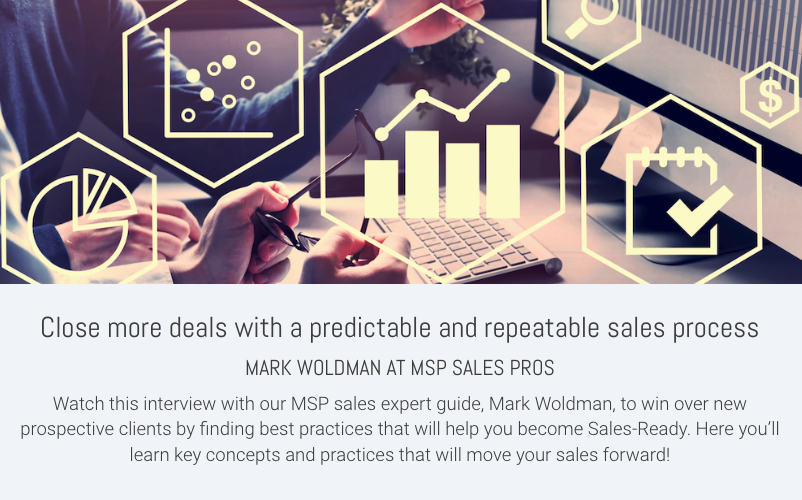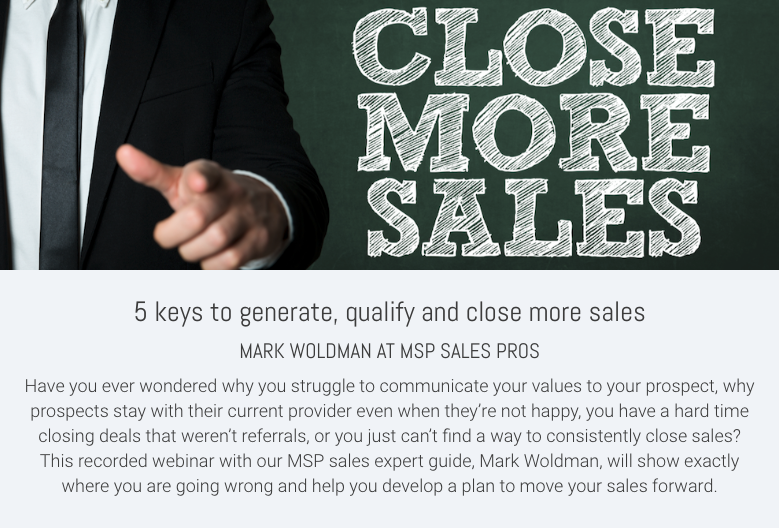

I’ve been talking with a fellow MSP entrepreneur recently about sales. He’s been suffering the inability to find the right someone for MSP contract sales, so he or the other directors are saddled with the sales work.
This is actually the usual situation among IT managed services providers... I see it all the time. The directors, CEOs and company presidents, are doing the sales for MSP services and neglecting their bailiwicks...developing the business.
The problem however is not HR, but the nature of the operation. Usually, when you find yourself unable to hire someone, and the high level staff are stuck doing it, you only see that symptom and not the root cause. In this case, the operational problem is causing the HR problem. The process is so complex that it narrows your field of potential hires. Only those with the most experience can manage it, and those people are most needed in other roles.
So let's see the typical MSP sales process of an MSP 2.0
- Lead generation: by referrals mostly, sometimes through networking.
- Opportunity qualification: no protocols in place for that, so everybody is the target group, from 2-5 people shops to enterprises of 200 and up.
- Client discovery process: technology-based assessments suited to ‘techs’, but the C-level of the MSP can also talk business with the client.
- Problem presentation: only a C-level MSP can properly execute this.
- Proposal: coming from the C-level again, preparing the solution
- Close: handshake between the client and MSP executives
- Follow up, execution, onboarding: this is where process starts to be seen
...and the obvious problems arising from it:
- This is not a scalable process. Each move forward costs the executive's time and jumbles priorities.
- Very hectic sales and operations cycles...so if the sales are brisk, the operation will also be demanding on the C-level, who will have to focus on execution. When the sales slow down, IT companies will be losing opportunities in the funnel as a result.
- The C-level is stuck in account management positions. They have the trust of the client company, so in every future endeavour the client will expect them to show up...and they are relegated to the delivery team.
- If nobody else has authority and accountability on the sales, only the C-level can do it.
- Devalues the role of the C-level of the MSP to the operational level in the eyes of the client.
- Working in the business instead of working on the company.
So currently the expected salesperson is by default a C-level executive, and not a dedicated sales professional, of whom there is no shortage in the workforce. Since we can’t change the facts of the status quo, we’ll change the sales process.
1. Create MSP sales roles:
There are three roles in sales, not one. You can distribute them to your existing people, or of course hire part-time or full-time pros.
Inside sales: creating qualified leads to generate opportunities, communicating by email, phone, and social networks.
Outside sales: visiting prospects, pre-sales, sales, nurturing the account, closing sales, visiting clients regularly, all the time spending company money on fuel, food and CRM software licenses.
Executive: maintaining high level connections, making conversation, meeting with clients when processes are stuck, or whenever executive encouragement is needed.
Account manager: all the up-selling to existing clients, and checking in on a monthly basis to do monthly/quarterly activities and to calculate the required budget for upcoming projects and new products.
If you’re able to separate these different functions, you’ll find you can get the right people from the labour market to work for you and achieve real results.
2. MSP sales process as a system
The sales process can be very long and complex. This isn’t a grocery store where the problem of hunger is solved in every aisle with little or no consultation. Our clients’ problems are layered and technical, often hard to see, and we are the ones who have to put together the solution. We need to actually get to know and understand the client. So for every step along the journey we better find the best practices and separate responsibilities.
Draw a funnel and divide it into three horizontal segments. These are the fundamentals of a remarkable MSP sales process:
The first one we call Top Of The Funnel (TOFU).
This is where prospects are made aware of our existence...they check our website, read our blogs, newsletters, etc. The best approach at this point is to provide valuable content in these mediums. It includes both inbound and outbound marketing...either they’re coming to us, or we’re drawing them.
The former is more likely to be long term and more engaging, while the latter is the traditional (not as fun) cold calling, ad-driven marketing we all know. Both have their merits; it’s just a decision where in the marketing and inbound sales territory you want to invest.
The second is the Middle of the Funnel (MOFU).
This is the evaluation period...we’re talking with the clients, discovering their company, and presenting our expertise. This person to person sales is the most effective method of doing business, with supportive inbound marketing materials like relevant blog posts and articles we’ve published. This helps distinguish our unique value proposition, so it’s critical that you have a system in place. This is the outside sales role, with support from executives, where we have to show who we are, and what we can do.
The third part is the Bottom of the Funnel (BOFU)
This is where the yes/no decisions are made, where we have the proposals, action plans, and company references. The critical item is the product - it needs to demonstrate it fits the needs of the client, so our ability to articulate those issues, the root of the problems, and a viable solution and a professional proposal is what matters.
You need a process to get your sales force in front of the client as soon as possible. This is again the responsibility of outside sales. The executives will come in only if necessary...they shouldn’t be tasked to close deals. If this is happening, then they’re not available for the higher level work only they can do.
After the closing, the growing phase is coming
...where you’re trying to sell more services to your existing clients, and performing the quarterly business reviews, yearly strategic sessions, and monthly phone calls. An annual executive check-in (not during the renewal phase) could further provide valuable feedback for both sides.
3. Automate and standardize
Now that you have the roles and the processes in place, standardization and automation come into play.
For TOFU, you can use marketing automation packages like Hubspot. You can leverage LinkedIn for prospecting, or any other cold calling agency you deem fit. Here’s where your scripts, email templates, and pre-written referral letters come in handy. Don’t over-think though: grab them from your favourite sources and have someone custom-edit to your enterprise.
For MOFU, you can use CRMs like Zoho, Salesforce, or the built-in PSA modules. I am surprised that only 20% of PSA users are using the CRM functionality or CRM integrations at all. A basic fact of MSP sales is that it’s usually time and problem based.. If your timing’s not right, you won’t be able to sell. You should nurture these prospects over time, so when the inevitable troubles come, you have everything covered.. Without CRM functionality, it’s just not going to happen.
For BOFU, you can use a proposal, an action plan, leaflets, agreements, or contract templates. However, usually regardless of all your effort, the client will flip to the last page where the pricing is located. The automation in this regard is more difficult as it involves person-to-person interaction as well.
The problem specifically involves the follow-ups, price recalculations, version revisions, and special clauses. Thus, you have to define follow-up processes, your non-negotiable bottom price for first clients, and the administration process for setting up new accounts. Taking care of these matters in advance will streamline your process so you can strike while the iron is hot.
Conclusion
No, this isn’t rocket surgery. Nonetheless it requires a fair amount of planning and dedicated work to accomplish, but the benefit is that you owners will have more free and creative time. If you’re not able to develop this process, automation, and roles, you will be working too much in the company rather than on the company, and squandering your entrepreneurial spirit on breathing life into your organization.



